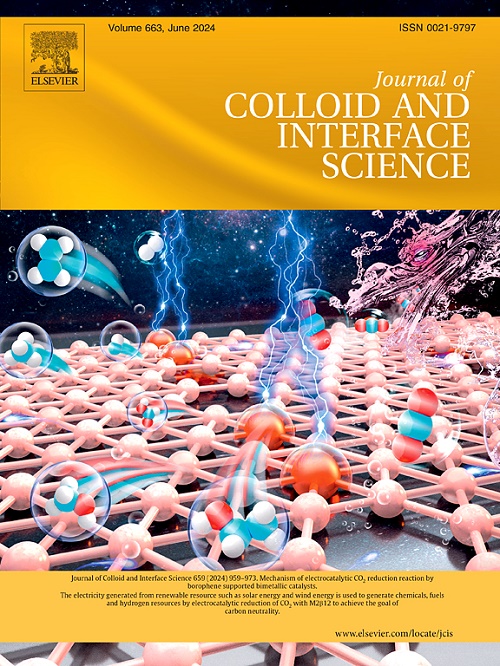阐明NU-1000/BiOCl-Ov复合材料中氧空位和z -图式异质结对增强盐酸四环素光催化降解的协同作用。
IF 9.7
1区 化学
Q1 CHEMISTRY, PHYSICAL
引用次数: 0
摘要
虽然z型异质结复合材料在光催化方面已经得到了广泛的研究,但对z型光催化剂中氧空位(Ov)的深入研究仍然很少。本文合理地设计和制备了氧空位修饰的具有z型异质结的NU-1000/BiOCl-Ov复合材料。结合x射线光电子能谱(XPS)和电子顺磁共振(EPR)实验验证了氧空位的存在,同时通过原位XPS、开尔文探针力显微镜(KPFM)研究、紫外光电子能谱(UPS)、EPR自由基捕获实验以及密度泛函数理论(DFT)计算详细证实了异质结界面上的Z-scheme电荷转移。重要的是,与原始的NU-1000和BiOCl相比,优化后的NU-1000/BiOCl- ov复合材料在可见光(λ≥400 nm)下降解盐酸四环素(TCH)的光催化性能增强。理论计算表明,氧空位可以诱导电子重新分布,促进O2和TCH分子的活化,从而提高光降解效率。此外,机理研究表明,氧空位和z型异质结的协同作用可以促进光生载流子的有效分离。最后提出了TCH的降解途径,并对降解中间体的毒性进行了评价。本研究强调了氧空位和z型异质结在提高光催化性能方面的协同作用,为高效光催化金属有机框架(MOFs)复合材料的设计提供了新的视角。本文章由计算机程序翻译,如有差异,请以英文原文为准。

Elucidating the synergistic effect of oxygen vacancies and Z-scheme heterojunction in NU-1000/BiOCl-Ov composites towards enhanced photocatalytic degradation of tetracycline hydrochloride
Although Z-scheme heterojunction composites have been widely studied in photocatalysis, in-depth investigation of oxygen vacancies (Ov) in the Z-scheme photocatalysts is still rare. Herein, an oxygen vacancies modified NU-1000/BiOCl-Ov composite with Z-scheme heterojunction was rationally designed and fabricated. The combination of X-ray photoelectron spectroscopy (XPS) and electron paramagnetic resonance (EPR) experiment verified the presence of oxygen vacancies, meanwhile the Z-scheme charge transfer across the heterojunction interface was confirmed in detail by the in situ-XPS, Kelvin probe force microscope (KPFM) studies, ultraviolet photoelectron spectroscopy (UPS), EPR radical capture experiment, as well as density functional theory (DFT) calculation. Importantly, compared to pristine NU-1000 and BiOCl, the optimized NU-1000/BiOCl-Ov composite displayed enhanced photocatalytic performance in the degradation of tetracycline hydrochloride (TCH) under visible light (λ ≥ 400 nm). Theoretical calculations reveal that the oxygen vacancies could induce electron redistribution, facilitating the activation of O2 and TCH molecules, thereby promoting the photodegradation efficiency. Moreover, mechanism studies suggested that the synergistic effect of oxygen vacancies and Z-scheme heterojunction could facilitate the effective separation of photogenerated carriers. At last, the degradation routes of TCH were proposed and the toxicity of degradation intermediates was assessed. This work underlines the cooperative functions of oxygen vacancies and Z-scheme heterojunction towards improved photocatalytic performance, which offers new perspectives on the design of metal–organic frameworks (MOFs) composites for efficient photocatalysis.
求助全文
通过发布文献求助,成功后即可免费获取论文全文。
去求助
来源期刊
CiteScore
16.10
自引率
7.10%
发文量
2568
审稿时长
2 months
期刊介绍:
The Journal of Colloid and Interface Science publishes original research findings on the fundamental principles of colloid and interface science, as well as innovative applications in various fields. The criteria for publication include impact, quality, novelty, and originality.
Emphasis:
The journal emphasizes fundamental scientific innovation within the following categories:
A.Colloidal Materials and Nanomaterials
B.Soft Colloidal and Self-Assembly Systems
C.Adsorption, Catalysis, and Electrochemistry
D.Interfacial Processes, Capillarity, and Wetting
E.Biomaterials and Nanomedicine
F.Energy Conversion and Storage, and Environmental Technologies

 求助内容:
求助内容: 应助结果提醒方式:
应助结果提醒方式:


